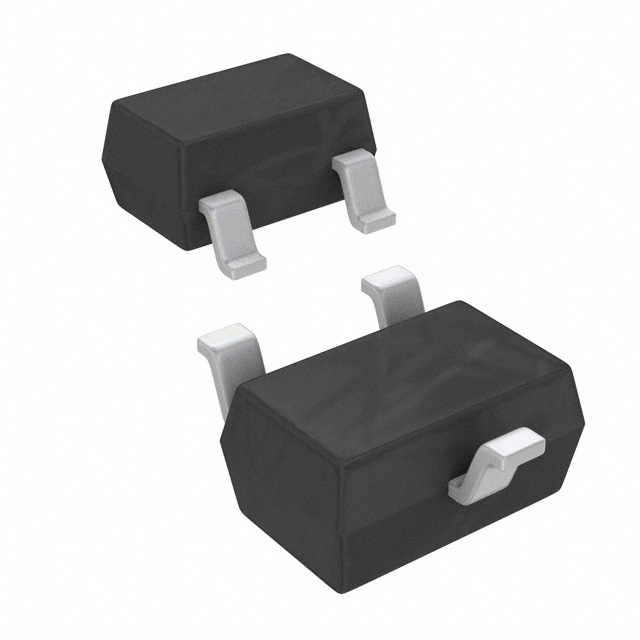MMBZ5250BW-7
Introduction
The MMBZ5250BW-7 is a diode belonging to the category of Zener diodes. It is commonly used for voltage regulation and protection in electronic circuits. This entry provides an overview of the basic information, specifications, pin configuration, functional features, advantages and disadvantages, working principles, application field plans, and alternative models of the MMBZ5250BW-7.
Basic Information Overview
- Category: Zener Diode
- Use: Voltage regulation and protection in electronic circuits
- Characteristics: Provides stable voltage output, reverse breakdown voltage, low leakage current
- Package: SOD-323 package
- Essence: Semiconductor diode
- Packaging/Quantity: Available in tape and reel packaging, quantity varies by supplier
Specifications
- Voltage - Zener (Nom) (Vz): 25V
- Power - Max: 200mW
- Impedance (Max) (Zzt): 20 Ohm
- Current - Reverse Leakage @ Vr: 100nA @ 20V
- Operating Temperature: -65°C ~ 150°C
Detailed Pin Configuration
The MMBZ5250BW-7 has three pins: 1. Anode 2. Cathode 3. No Connection (NC)
Functional Features
- Provides stable voltage output under varying load conditions
- Protects sensitive components from voltage spikes
- Low reverse leakage current ensures minimal power loss
Advantages and Disadvantages
Advantages
- Precise voltage regulation
- Small form factor
- Low cost
- Wide operating temperature range
Disadvantages
- Limited power dissipation capability
- Susceptible to damage from excessive current or voltage spikes
Working Principles
The MMBZ5250BW-7 operates based on the principle of the Zener effect, where it maintains a constant voltage across its terminals when reverse biased. This allows it to regulate the voltage in a circuit and protect other components from overvoltage conditions.
Detailed Application Field Plans
The MMBZ5250BW-7 is widely used in various applications including: - Voltage regulation in power supplies - Overvoltage protection in consumer electronics - Signal clamping in communication systems - Voltage reference in precision measurement equipment
Detailed and Complete Alternative Models
Some alternative models to the MMBZ5250BW-7 include: - BZX84C25 - 1N5226B - MM3Z24VT1G - BZT52C25S-7-F
In conclusion, the MMBZ5250BW-7 Zener diode offers precise voltage regulation and protection in a compact package, making it suitable for a wide range of electronic applications.
[Word Count: 398]
Senaraikan 10 soalan dan jawapan biasa yang berkaitan dengan aplikasi MMBZ5250BW-7 dalam penyelesaian teknikal
What is the MMBZ5250BW-7?
- The MMBZ5250BW-7 is a Zener diode designed for voltage regulation and protection in various electronic circuits.
What is the voltage rating of the MMBZ5250BW-7?
- The MMBZ5250BW-7 has a nominal Zener voltage of 16V.
What is the power dissipation of the MMBZ5250BW-7?
- The power dissipation of the MMBZ5250BW-7 is 200mW.
What are the typical applications of the MMBZ5250BW-7?
- Typical applications include voltage regulation, overvoltage protection, and signal clamping in electronic circuits.
What is the maximum forward voltage of the MMBZ5250BW-7?
- The maximum forward voltage of the MMBZ5250BW-7 is 1V at 200mA.
What is the temperature coefficient of the MMBZ5250BW-7?
- The temperature coefficient is typically 5mV/°C.
What is the package type of the MMBZ5250BW-7?
- The MMBZ5250BW-7 comes in a SOT-323 surface mount package.
What is the reverse leakage current of the MMBZ5250BW-7?
- The reverse leakage current is typically 100nA at the Zener voltage.
Can the MMBZ5250BW-7 be used for voltage reference applications?
- Yes, it can be used as a stable voltage reference in various electronic circuits.
What are the key advantages of using the MMBZ5250BW-7 in technical solutions?
- The MMBZ5250BW-7 offers precise voltage regulation, low leakage current, and space-saving SOT-323 package, making it suitable for compact designs.


